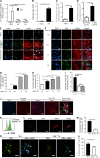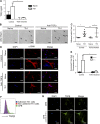Th1 effector T cells selectively orchestrate cardiac fibrosis in nonischemic heart failure
- PMID: 28970239
- PMCID: PMC5679176
- DOI: 10.1084/jem.20161791
Th1 effector T cells selectively orchestrate cardiac fibrosis in nonischemic heart failure
Abstract
Despite emerging data indicating a role for T cells in profibrotic cardiac repair and healing after ischemia, little is known about whether T cells directly impact cardiac fibroblasts (CFBs) to promote cardiac fibrosis (CF) in nonischemic heart failure (HF). Recently, we reported increased T cell infiltration in the fibrotic myocardium of nonischemic HF patients, as well as the protection from CF and HF in TCR-α-/- mice. Here, we report that T cells activated in such a context are mainly IFN-γ+, adhere to CFB, and induce their transition into myofibroblasts. Th1 effector cells selectively drive CF both in vitro and in vivo, whereas adoptive transfer of Th1 cells, opposite to activated IFN-γ-/- Th cells, partially reconstituted CF and HF in TCR-α-/- recipient mice. Mechanistically, Th1 cells use integrin α4 to adhere to and induce TGF-β in CFB in an IFN-γ-dependent manner. Our findings identify a previously unrecognized role for Th1 cells as integrators of perivascular CF and cardiac dysfunction in nonischemic HF.
© 2017 Nevers et al.
Figures







Similar articles
-
CXCR3 regulates CD4+ T cell cardiotropism in pressure overload-induced cardiac dysfunction.JCI Insight. 2019 Apr 4;4(7):e125527. doi: 10.1172/jci.insight.125527. eCollection 2019 Apr 4. JCI Insight. 2019. PMID: 30779709 Free PMC article.
-
Cytokine-Like 1 Regulates Cardiac Fibrosis via Modulation of TGF-β Signaling.PLoS One. 2016 Nov 11;11(11):e0166480. doi: 10.1371/journal.pone.0166480. eCollection 2016. PLoS One. 2016. PMID: 27835665 Free PMC article.
-
Heart-infiltrating prominin-1+/CD133+ progenitor cells represent the cellular source of transforming growth factor beta-mediated cardiac fibrosis in experimental autoimmune myocarditis.Circ Res. 2009 Aug 28;105(5):462-70. doi: 10.1161/CIRCRESAHA.109.196287. Epub 2009 Jul 23. Circ Res. 2009. PMID: 19628793
-
Immunological aspect of cardiac remodeling: T lymphocyte subsets in inflammation-mediated cardiac fibrosis.Exp Mol Pathol. 2011 Feb;90(1):74-8. doi: 10.1016/j.yexmp.2010.10.004. Epub 2010 Oct 19. Exp Mol Pathol. 2011. PMID: 20965166 Review.
-
The role of cardiac fibroblasts in the transition from inflammation to fibrosis following myocardial infarction.Vascul Pharmacol. 2013 Mar;58(3):182-8. doi: 10.1016/j.vph.2012.07.003. Epub 2012 Aug 3. Vascul Pharmacol. 2013. PMID: 22885638 Review.
Cited by
-
Pulmonary Fibrosis as a Result of Acute Lung Inflammation: Molecular Mechanisms, Relevant In Vivo Models, Prognostic and Therapeutic Approaches.Int J Mol Sci. 2022 Nov 29;23(23):14959. doi: 10.3390/ijms232314959. Int J Mol Sci. 2022. PMID: 36499287 Free PMC article. Review.
-
Genome-Wide Association Study Identifies ROBO2 as a Novel Susceptibility Gene for Anthracycline-Related Cardiomyopathy in Childhood Cancer Survivors.J Clin Oncol. 2023 Mar 20;41(9):1758-1769. doi: 10.1200/JCO.22.01527. Epub 2022 Dec 12. J Clin Oncol. 2023. PMID: 36508697 Free PMC article.
-
Perivascular Adventitial Fibroblast Specialization Accompanies T Cell Retention in the Inflamed Human Dermis.J Immunol. 2019 Jan 1;202(1):56-68. doi: 10.4049/jimmunol.1801209. Epub 2018 Dec 3. J Immunol. 2019. PMID: 30510068 Free PMC article.
-
Immunometabolism at the Heart of Cardiovascular Disease.JACC Basic Transl Sci. 2023 Apr 26;8(7):884-904. doi: 10.1016/j.jacbts.2022.12.010. eCollection 2023 Jul. JACC Basic Transl Sci. 2023. PMID: 37547069 Free PMC article. Review.
-
Immune Dysregulation in HFpEF: A Target for Mesenchymal Stem/Stromal Cell Therapy.J Clin Med. 2020 Jan 16;9(1):241. doi: 10.3390/jcm9010241. J Clin Med. 2020. PMID: 31963368 Free PMC article. Review.
References
-
- Blanton R.M., Takimoto E., Lane A.M., Aronovitz M., Piotrowski R., Karas R.H., Kass D.A., and Mendelsohn M.E.. 2012. Protein kinase g iα inhibits pressure overload-induced cardiac remodeling and is required for the cardioprotective effect of sildenafil in vivo. J. Am. Heart Assoc. 1:e003731 10.1161/JAHA.112.003731 - DOI - PMC - PubMed
MeSH terms
Substances
Grants and funding
LinkOut - more resources
Full Text Sources
Other Literature Sources
Medical
Molecular Biology Databases
Research Materials
Miscellaneous

